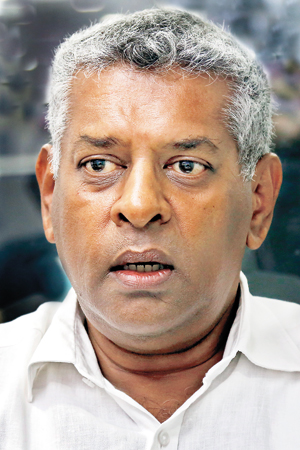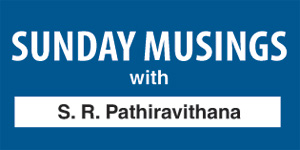Looking for that Tennis revolution in Sri Lanka
View(s):
Former Sri Lankan international Aruna Seneviratne
Once, a friend of mine was commenting on our past. He let off a sigh and commented, “Oh! In the past we built all these sky-scraping monuments, while the Europeans were leading a primitive life”. I listened intensely, keeping my comments to myself.
However, to a great extent, we thrive gloating about our past and sigh about what we possessed yesterday, not on how we should be perched tomorrow. Yes, in a sporting sense, we talk of Susanthika Jayasingha in athletics, the Aluvihares in hockey, the Hashimdeens and P.D. Sirisenas in football, M.J.M. Lafir in billiards, a list longer than my writing limb in cricket, and Arjun Fernando and a few others in tennis. Yet, the present belongs to poor ‘Old Mother Hubbard’.
Yet, the background to my exercise was the barren Asian Games and I picked on tennis, just to have an insight into the workings of this sport.
The Sunday Musings picked on the expertise of former Lankan tennis international Aruna Seneviratne who is also a selector, to share some thoughts on the subject.
Bluntly, we asked Aruna: Is our tennis stagnant, internationally? Thoughtfully, Seneviratne answered, “I wouldn’t disagree with you completely. It is stagnant but, it is stagnant for different reasons. Some reasons are beyond the control of anybody, while there are other reasons, I am sure, that something could be done about.”
Then, he elaborated on his statement. “Over the past several years, may be the past decade, we have done a lot for tennis, where the game has been broad-based, especially at the initial stages. We have a very good mini tennis programme. Now, especially in the lower level, the numbers have increased a lot and the base broadened from Under (U)-7 to U-14. Now, we have huge numbers taking part in the game. For example, if you take U-14 events, any open event would have over 128 entries. But, when it comes to U-16, it drops to about 80-90 and, when it comes to the age of eighteen, the draw is about 32. In Open Women’s Singles, we have less than 16 entries. Yes, the numbers dwindle but, with reasons. What happens is that, the minute they are over 14, a lot of them take time off to do the O’ Level Exam, which is kind of inevitable. But, the numbers that pick up and play after that decrease.
“The main reason for that is, a lot of junior boys and girls, especially the ones with means, use tennis as a way of getting into foreign universities. There are a lot of tennis scholarships in the USA. So, the aspirations are different, continuity is not a factor; it is not so high in their agenda”.
Seneviratne pointed out that this occurs more in the women’s segment, while there are a greater number of boys tennis players who come back and take part in tournaments. He said, “Some still come back and take part in our tournaments, may be during their summer holidays or, make themselves available to take part in the Nationals. As for Women Tennis players, it is very rarely that they come back to take part in our tournaments. A good example is in the U-18 Open National Singles, which was won by Savith Gunawardena who is on holiday while studying in the US.”
Seneviratne said these opportunities are increasing day by day, especially among the lesser known US universities. In US universities now, other than the big three sports — baseball, basketball and American football, minor sports also receive funding. Hence, he sees this as a primary reason for budding tennis players to move out from the Lankan circuit.
The Musings then pointed out there was an era when tennis was more accessible to the public. There were many tennis courts and clubs. How have they closed shop. Seneviratne said, “Yes, there was an era when the club system was thriving. Even the outstation clubs were very vibrant and active. Now what is happening is that, I feel the coaching aspect of it has made it lucrative. Since tennis has been introduced from the U-7 level, mini tennis in schools and its success is based upon how they perform at the U-7, U-8, U-9 level – it’s thriving. Though, there is no direct public school competition, there are mini tennis carnivals and a lot of schools take part in them.”
We asked the former tennis international about the international aspiration of the SLTA and medal hopes. “Ideally, how I see it is, any country’s aspirations are fuelled by a success story. If there is a successful player, it would work. It is difficult to inspire something out of nothing. Just coming up with slogans does not work. In Sweden, their tennis revelation occurred when Bjorn Borg adorned the scene. In 1976, he became Wimbledon champion and, from there on, Sweden went on to produce a whole lot of international tennis stars.”
“In Sri Lanka, when Arjun Fernando was ruling the court, we also produced Umesh Walooppillai, Rohan Fernando and Jayendra Wijesekera. Then, when Sanjaya Godamanne came into the scene, the impact was not as much but, we did produce some good players like Rajiv Rajapakse, Franklyn Emmanuel and Dinesh Kanthan, and there were some sort of worthwhile international competition. We, essentially, have been dependent on one person to star and then others to be inspired by him. We never had a tennis movement, so to speak. We never had a tennis revolution.”
Then the Musings asked him about the present lot of local tennis stars. Seneviratne said, “Right now Shamal Dissanayake is number one, Dinesh Kanthan is number two and Asitha de Silva is number 3. Among Women, of the ones who are here Anika Seneviratne is the clear number one, while Angelika Curera looks number two. Nethmi Waduge did not take part in the open, as she is sitting for her exams, and she is a huge contender. Then there is Janeli Mamanperi and Savini Jayasuriya. But, to my mind, they are not strong enough, really, to be up there. What they have done is that they have beaten each other but, they have not beaten anyone of significance, to really cement their standard.”
Seneviratne pointed out that countries such as Nepal and Vietnam are really making use of the limited international exposure they receive. He said that, a few years ago, Nepal was several grades below our standard, but recently, they won an U-12 tournament against Sri Lanka. Then Vietnam, which took to tennis very recently, has already been in a Junior Wimbledon final. “In the so-called enclaves in Asia, tennis has risen tremendously. These countries have made use of the opportunities that have come their way, while some of our players opt to skip some tough tournament, to preserve their rankings. What we should be doing is be a part of the high performance training. We have done the broad-basing part of it successfully, but to make use of what comes from that, we should concentrate on high performance, it is absolutely necessary, it’s a crying need.”
 He said that, when present NOCSL President Suresh Subramanium was SLTA President, he brought this concept of broad-basing tennis successfully, and bring a lot of competition here. Now we should look to get his help for more opportunities.
He said that, when present NOCSL President Suresh Subramanium was SLTA President, he brought this concept of broad-basing tennis successfully, and bring a lot of competition here. Now we should look to get his help for more opportunities.
Seneviratne, being a member of the tennis selection committee, we finally inquired of what occurred at the Asian Games – the Selection conundrum? Hesaid, “As far as the selection issues for the Asian Games were concerned, there were many things that were misconstrued by many people. I would say, as far the Selection Committee is concerned, the issue that we should have dealt with earlier, when the process that we took was very transparent and some players withdrew, we still continued with the process, because the process had already started. But, on reflection, we should have reevaluated the process, once some players withdrew from the trials, that is where we were wrong. The ranking points are not there to select players. If you use the ranking points to select players, you don’t need a Selection Committee. Ranking points is only a guideline. But, when you are selecting a team, you must find out and, if you are going for a person, what he or she has been doing over a period of 12 months. You have to select the best player at that moment. That is why there is some emphasis laid on trials that we play. We reward the players for what they have done throughout the year, by selecting players who are in the higher ranks, and for them to come into the trials at the latter stage.”


